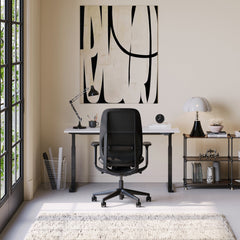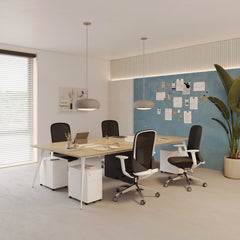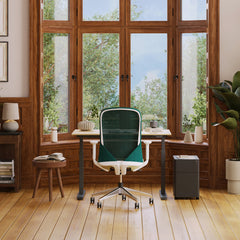Get 10% off your first order
Find the office furniture that’s designed to match your style, comfort, and needs perfectly. Subscribe
Beyond Desks and Chairs: How Cohesive Design Shapes Your Office Brand

Visit quiz page to see how we makes it easy to create an inspiring workplace

Modern workspaces are redefining what it means to invest in quality furniture. The focus has shifted from short-term convenience to long-term sustainability, combining ergonomic comfort with environmental responsibility. A sustainable office chair is more than a piece of furniture it is a daily instrument that supports posture, productivity, and the planet.
Sustainable seating aligns workplace wellness with ecological consciousness. Organizations that adopt sustainable furnishings see improved durability, reduced waste, and enhanced well-being for their teams. Even remote workers are recognizing the difference a thoughtfully engineered chair can make to both comfort and conscience.
Furniture choices now reflect an organization’s values. Companies that select responsibly built chairs signal commitment to their environmental and social responsibilities. Chairs constructed with renewable materials and designed for extended use help minimize environmental footprint while projecting a strong message of purpose-driven leadership.
Ergonomics supports long-term health, and sustainability ensures that this support continues for years. According to the NIOSH guidance on workstation ergonomics, proper seating posture reduces fatigue and prevents musculoskeletal strain. When ergonomic design is paired with eco-friendly materials and repairable components, sustainability and health form a single, mutually reinforcing framework.

Sustainability is a measurable outcome, not a marketing term. A truly sustainable office chair reveals transparency in sourcing, longevity in design, and ethics in production.
Materials determine both a chair’s environmental footprint and its comfort level. Recycled aluminum provides structure and longevity, while FSC-certified wood offers renewable warmth. Textiles made with low-emission dyes and post-consumer fibers protect indoor air quality. The recycled-composite Novo ergonomic design exemplifies how sustainable material engineering can deliver performance, comfort, and aesthetics in balance.
Repairability defines true sustainability. Chairs that allow for easy replacement of arms, casters, or seat cushions extend service life while minimizing landfill contribution. Tools like the Build Your Bundle configuration suite enable buyers to customize and standardize furniture parts, ensuring consistency and ease of maintenance across evolving office layouts.
Circular design embraces reuse and recycling as design principles. Disassemblable frames, recyclable metals, and minimal packaging all contribute to a circular economy. Every stage—from sourcing to disposal—is accounted for within a sustainable chair’s lifecycle.
| Attribute | Recycled Metal Frame | FSC-Certified Wood Accents | Mixed-Plastic Commodity Parts |
|---|---|---|---|
| Structural Durability | High | Medium to High | Variable |
| Recyclability at End-of-Life | High | Medium | Low |
| Maintenance Needs | Low | Low to Medium | Medium to High |
| Indoor Air Quality | Excellent with compliant finishes | Good with proper sealing | Variable |
| Disassembly Ease | Straightforward | Moderate | Difficult |
An ergonomic chair does more than improve posture—it extends the lifespan of both the user and the product. When comfort is sustained, there is less motivation to replace the chair prematurely, reducing material turnover.
Ergonomic range defines usability. Seat height, depth, lumbar tension, and armrest flexibility should adapt to individual users. The Onyx ergonomic posture-focused chair demonstrates how adaptive mechanics and energy-efficient manufacturing coexist to promote both comfort and sustainability.
High-resilience foams and ventilated meshes balance support and breathability. Upholstery designed for easy cleaning and fade resistance enhances both longevity and hygiene. Sustainable comfort materials allow the chair to remain supportive through years of continuous use.
A chair that looks and feels harmonious invites better posture and longer engagement. The Muse chair with organic contours integrates tactile materials and smooth geometry that foster calm concentration. Natural design elements promote wellness and underscore the emotional dimension of sustainable seating.

Sustainability represents prudent resource management, not extravagant promises. The most valuable chairs balance cost, comfort, and long-term durability to provide real return on investment.
Instead of focusing solely on initial price, consider lifespan, part availability, and maintenance needs. Evaluating sustainability through these dimensions prevents waste and ensures consistent performance.
| Evaluation Area | Indicators of Long-Term Value | Questions to Ask |
|---|---|---|
| Structure | Metal subframes and reliable mechanisms | Can it be serviced if the tilt locks fail? |
| Upholstery | Durable fabrics with clear cleaning guidance | Is it easy to maintain over time? |
| Components | Standardized casters and hardware | Are replacement parts available? |
| Adjustability | Stable settings with smooth operation | Do adjustments hold under daily use? |
| Documentation | Clear maintenance and recycling info | Are lifecycle details provided? |
Serviceable chairs require minimal upkeep and rarely need full replacement. Reduced turnover conserves resources and lowers long-term expenditure.
Healthy seating correlates directly with focus and endurance. Chairs that promote neutral posture reduce discomfort, allowing teams to remain productive without distraction. Ergonomic sustainability thus creates tangible workplace value.
The aesthetics of sustainable design influence how people feel about their workspaces. Well-coordinated environments encourage collaboration and satisfaction.
Unified design across departments reinforces a brand’s professionalism and sustainability goals. Selecting from Urbanica’s sustainable seating collection enables consistent visual and ergonomic identity throughout an organization.
Pairing sustainable chairs with responsibly crafted office desks enhances both comfort and environmental responsibility. Integrated systems maintain alignment between form and function while minimizing excess purchasing.
Subtle design language often has the most lasting impact. The Seashell chair with biomorphic shell exemplifies elegant minimalism that reduces material use without sacrificing durability or comfort.
In an era of green marketing, identifying genuinely sustainable furniture requires discernment and verification.
Look for GREENGUARD, BIFMA LEVEL, FSC, and ISO 14001 certifications. Each validates low emissions, responsible sourcing, and environmental management standards. Multiple certifications indicate robust commitment.
Manufacturers that share detailed specifications, disassembly diagrams, and maintenance instructions demonstrate accountability. This openness is often a more reliable indicator of sustainability than slogans.
Ambiguous terms like “eco-friendly” without data or documentation should raise concern. Transparent brands disclose their methods and welcome scrutiny.
1. Confirm third-party certifications.
2. Request component lists and material data sheets.
3. Review cleaning and repair instructions.
4. Ensure ergonomic adjustability fits intended users.
5. Verify recycling or return options.
A sustainable chair adapts seamlessly to various environments, maintaining comfort and function wherever work occurs.
Compact, ergonomic designs optimize limited spaces while maintaining adjustability. Easy-clean materials and floor-safe casters support hybrid work without sacrificing longevity.
In collaborative settings, broad adjustment ranges and durable surfaces ensure comfort for multiple users. Chairs with intuitive controls and resilient materials withstand daily rotation and frequent adjustments.
Meeting spaces benefit from chairs that combine stability and quiet operation. Smooth-gliding casters, silent tilt mechanisms, and stain-resistant fabrics enhance both comfort and acoustic quality.
Longevity depends on consistent care. Regular inspections and gentle cleaning prevent small issues from shortening a chair’s life.
Every 3 months: Vacuum mesh or fabric, check fasteners, clear debris from casters.
Twice a year: Lubricate moving parts and test adjustments for smoothness.
Once a year: Assess cylinder performance, replace worn pads or wheels, and tighten base bolts.
Use mild soap solutions or manufacturer-approved cleaners. Avoid harsh solvents that degrade finishes. Mesh benefits from gentle brushing, and wooden accents require soft, dry cloth maintenance. These small actions maintain comfort and appearance for years.
Material behavior determines how a chair performs over time. Understanding it helps buyers make informed decisions.
Breathable mesh designs encourage air circulation and reduce heat buildup. High-tension weaves maintain posture support and shape retention, preventing sagging.
Layered foams distribute weight evenly, reducing pressure points. Open-cell structures allow air to flow, which helps the cushion maintain elasticity longer.
Chairs with continuous, load-bearing loops resist structural fatigue better than multi-part frames. Robust geometry ensures stability and quieter movement through years of use.
Planning for the end of a product’s life closes the sustainability loop.
Standard bolts and screws make disassembly easier. Avoiding glued or fused parts allows materials to be sorted and recycled efficiently.
Separate metals, plastics, and textiles for appropriate recycling streams. Some communities offer specialized programs for furniture reclamation; participating extends sustainability beyond ownership.
A sustainable chair must also be intuitive to adjust. Ease of use ensures that ergonomic benefits are fully realized.
Keep feet flat on the floor.
Align knees slightly below hips.
Maintain contact between lumbar support and lower back.
Adjust armrests to keep elbows near 90 degrees.
Position screens at eye level to reduce neck strain.
These simple adjustments protect posture, enhance focus, and sustain comfort through the day.
Ergonomic seating achieves maximum impact when it integrates with other sustainable design elements. Coordinated choices minimize redundancy and create cohesive environments.
Standardized finishes and materials simplify reconfiguration during growth. When offices expand, compatible furniture reduces waste and maintains design continuity.
Digital tools help visualize space layout and materials. The Build Your Bundle configuration suite supports smart planning, ensuring efficient use of space and resources while preserving aesthetic harmony.
Sustainable office furniture now evolves under a global lens. International benchmarks are driving higher accountability and innovation.
Programs such as LEED and the EU Ecolabel evaluate the environmental impact of furniture production, while BIFMA G1 and ISO 9241 define ergonomic quality. These frameworks ensure that sustainability and user comfort advance together.
Different regions interpret sustainability through distinct priorities:
North America: Emphasizes lifecycle transparency and modular furniture systems.
Europe: Prioritizes recyclability and low-carbon manufacturing.
Asia-Pacific: Focuses on renewable material innovation and efficient logistics.
These regional approaches collectively raise global manufacturing standards.
Modern manufacturers analyze ergonomic design data alongside environmental metrics. By evaluating how materials and movement mechanisms influence both comfort and emissions, they create balanced, efficient products that meet evolving user and regulatory expectations.
Sustainability certification is now a deciding factor in furniture procurement. Businesses integrate verified environmental data into their purchasing decisions, ensuring that every new chair aligns with corporate environmental goals.
Emerging innovations traceable materials, biodegradable textiles, and simplified assembly—will define the next generation of office seating. Sustainable chairs are becoming not just an alternative but the new standard, blending ethics, engineering, and comfort for workplaces worldwide.
Sustainable office chairs reflect a shared responsibility to design environments that respect both people and the planet. They represent a balanced investment in health, durability, and ecological stewardship—proving that comfort and conscience can sit side by side for years to come.

Beyond Desks and Chairs: How Cohesive Design Shapes Your Office Brand

The Silent Energy Drain: Designing Tables and Chairs That Fight Work Fatigue

The Performance Equation: Unlocking Employee Potential with Ergonomic Design
Get 10% off your first order
Find the office furniture that’s designed to match your style, comfort, and needs perfectly. Subscribe
Leave a comment